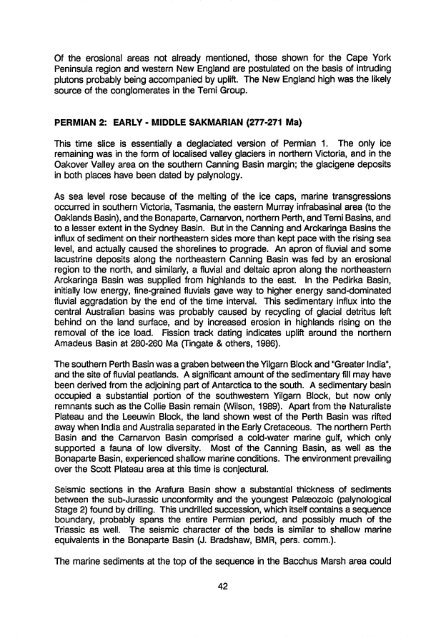II II II II II - Geoscience Australia
II II II II II - Geoscience Australia
II II II II II - Geoscience Australia
Create successful ePaper yourself
Turn your PDF publications into a flip-book with our unique Google optimized e-Paper software.
Of the erosional areas not already mentioned, those shown for the Cape York<br />
Peninsula region and western New England are postulated on the basis of intruding<br />
plutons probably being accompanied by uplift. The New England high was the likely<br />
source of the conglomerates in the Temi Group.<br />
PERMIAN 2: EARLY - MIDDLE SAKMARIAN (277-271 Ma)<br />
This time slice is essentially a deglaciated version of Permian 1. The only ice<br />
remaining was in the form of localised valley glaciers in northern Victoria, and in the<br />
Oakover Valley area on the southern Canning Basin margin; the glacigene deposits<br />
in both places have been dated by palynology.<br />
As sea level rose because of the melting of the ice caps, marine transgressions<br />
occurred in southern Victoria, Tasmania, the eastern Murray infrabasinal area (to the<br />
Oaklands Basin), and the Bonaparte, Carnarvon, northern Perth, and Temi Basins, and<br />
to a lesser extent in the Sydney Basin. But in the Canning and Arckaringa Basins the<br />
influx of sediment on their northeastern sides more than kept pace with the rising sea<br />
level, and actually caused the shorelines to prograde. An apron of fluvial and some<br />
lacustrine deposits along the northeastern Canning Basin was fed by an erosional<br />
region to the north, and similarly, a fluvial and deltaic apron along the northeastern<br />
Arckaringa Basin was supplied from highlands to the east. In the Pedirka Basin,<br />
initially low energy, fine-grained fluvials gave way to higher energy sand-dominated<br />
fluvial aggradation by the end of the time interval. This sedimentary influx into the<br />
central <strong>Australia</strong>n basins was probably caused by recycling of glacial detritus left<br />
behind on the land surface, and by increased erosion in highlands rising on the<br />
removal of the ice load. Fission track dating indicates uplift around the northern<br />
Amadeus Basin at 280-260 Ma (Tingate & others, 1986).<br />
The southern Perth Basin was a graben between the Yilgarn Block and "Greater India",<br />
and the site of fluvial peatlands. A significant amount of the sedimentary fill may have<br />
been derived from the adjoining part of Antarctica to the south. A sedimentary basin<br />
occupied a substantial portion of the southwestern Yilgarn Block, but now only<br />
remnants such as the Collie Basin remain (Wilson, 1989). Apart from the Naturaliste<br />
Plateau and the Leeuwin Block, the land shown west of the Perth Basin was rifted<br />
away when India and <strong>Australia</strong> separated in the Early Cretaceous. The northern Perth<br />
Basin and the Carnarvon Basin comprised a cold-water marine gulf, which only<br />
supported a fauna of low diversity. Most of the Canning Basin, as well as the<br />
Bonaparte Basin, experienced shallow marine conditions. The environment prevailing<br />
over the Scott Plateau area at this time is conjectural.<br />
Seismic sections in the Arafura Basin show a substantial thickness of sediments<br />
between the sub-Jurassic unconformity and the youngest Palmozoic (palynological<br />
Stage 2) found by drilling. This undrilled succession, which itself contains a sequence<br />
boundary, probably spans the entire Permian period, and possibly much of the<br />
Triassic as well. The seismic character of the beds is similar to shallow marine<br />
equivalents in the Bonaparte Basin (J. Bradshaw, BMR, pers. comm.).<br />
The marine sediments at the top of the sequence in the Bacchus Marsh area could<br />
42

















